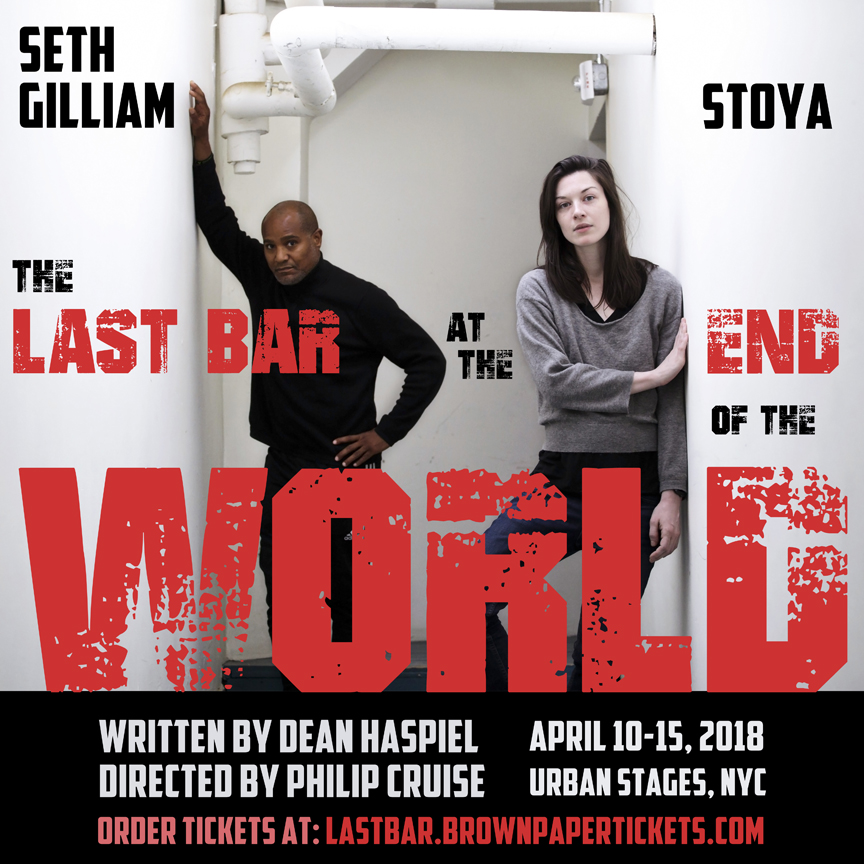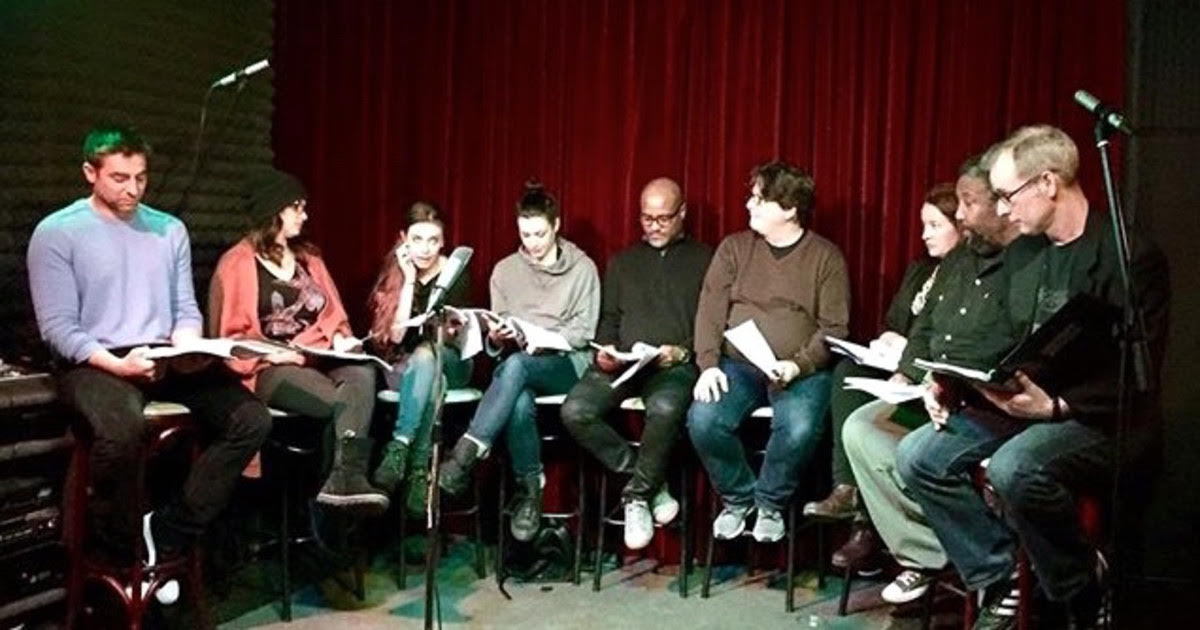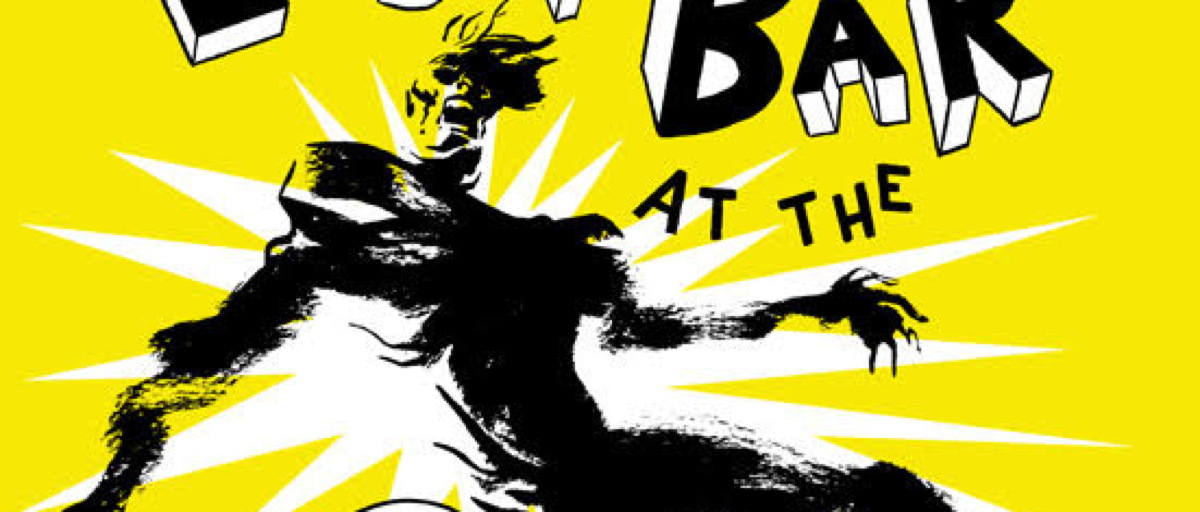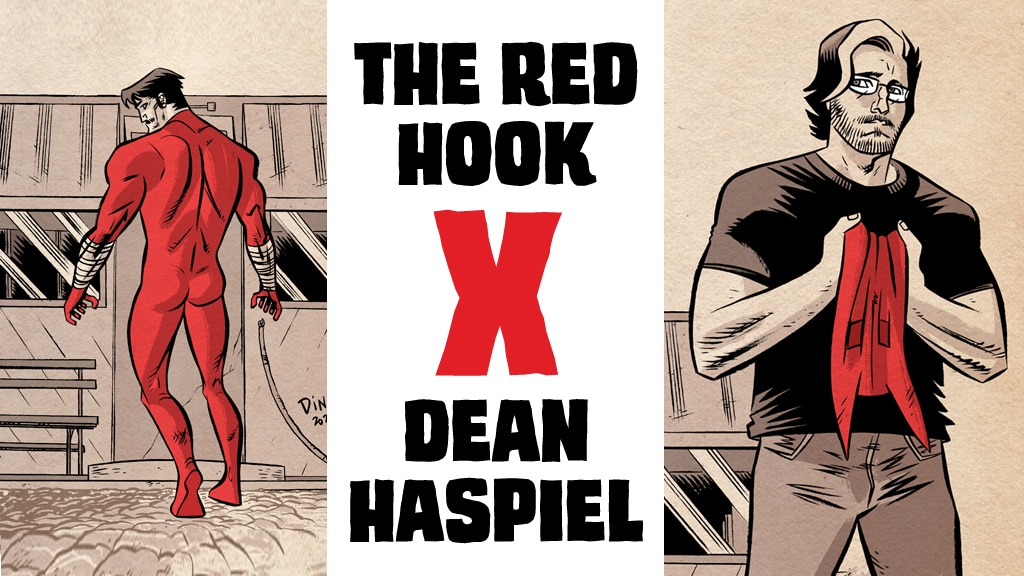
Dean Haspiel’s prowess as a cartoonist is well known, but he’s now an emerging playwright as well. His new play, The Last Bar at the End of the World opens tomorrow at Urban Stages in Manhattan – you can buy tickets here.
Directed by Phillip Cruise, and starring Cruise, Tarik Davis, Lex Friedman, Seth Gilliam, Christopher Lee, Edward Miller, Alyssa Simon, Anna Stefanic, and Stoya, it’s a worthy follow up to Harikari Kane, which ran last fall, which was a mind bending, heartbreaking exploration of the meaning of death – and life – told with poetry and passion.
Cruise was a cast member of that production and he, Haspiel and stars Seth Gilliam (The Walking Dead) and Stoya (known for her adult film work and activism but also an award-winning actress) to talk about the play and its meaning in this roundtable.
The Last Bar At The End of the World has more to say about death, our search for meaning and even Jack Kirby. Big themes but ones which Haspiel handles with skill and insight. The plat involves a cartoonist who is dying and the strange characters including Gilliam and Stoya) who inhabit the world of the Last Bar
THE BEAT: This play is your third play, Dean, and they share a common background. Is this a trilogy or is this shared universe even larger?
HASPIEL: When I wrote my first play, SWITCH TO KILL, I didn’t intend to launch an expanding universe like I did with my “New Brooklyn Universe” comix at LINE Webtoons, featuring The Red Hook, War Cry, The Purple Heart, and more. But, world-building comes naturally to comic books, and to me. When I wrote my second play, HARAKIRI KANE (aka Die! Die, Again!!), I had a scene that begged to be connected to my first play and so I mollified the muse. When I was writing my third play, THE LAST BAR AT THE END OF THE WORLD, I intentionally made a connection to all three stories, ergo a trilogy, which are loosely tethered by, of all things, existential hit men.

THE BEAT: The setting is a bar where various folks play out their stories. Did any of the cast and crew bring real life bar stories to their interpretations?
HASPIEL: To keep my script writing process pure, I didn’t consult anyone except for director Phil Cruise who asked me questions about the bar and its purpose. We had a lot of conversations about what the Last Bar is and what it means to me so that he could impart his own understanding as a director. The bar I occasion in real life is Sunny’s Bar on the waterfront in Red Hook, BK/NY. It’s like a church. But, despite its spiritual influence on me the past two decades, the “Last Bar” in my play is not Sunny’s, at all. The Last Bar is something else. But, I always encourage my theatrical collaborators to imbue my characters with their personal experiences. Make my story theirs so that it becomes ours.
THE BEAT: Did you write this one after Harakiri Kane, or were they sitting in a drawer somewhere waiting for the stage magic to happen? What did you learn writing this play?
HASPIEL: My new play is a combination of the best parts of a screenplay I wrote years ago coupled with a few essays I wrote while on retreat at Yaddo (the artists residency in Saratoga Springs, NY), and a lot of brand new stuff. It’s more emotionally autobiographical than my other plays, and funnier. The idea of a “post-truth” world bugs me and I wanted to wrestle with that while addressing other, more personal concerns.
And, with what I’ve observed and listened to, watching these incredible directors and actors create a living space out of minimal means, elevates my game, as I focus on character and pace over props and place. I specifically wrote a charged scene between Seth Gilliam and Stoya, hoping they would agree to perform it. But, seeing it breathe and behaved is so different from reading it in your head and I adjust my script accordingly for maximum impact.
THE BEAT: In your notes that you sent me you mentioned that a lot of this play is influenced by Jack Kirby, the great comics artist. How do cartooning and comics intersect with the story?
HASPIEL: The poster image is an homage to Jack Kirby’s Bruce Banner who, for those few not in the know, was blasted by Gamma rays and transformed into the Incredible Hulk. And, even though there is no Hulk in the Last Bar, the story deals with transformations, and Jack Kirby, my favorite cartoonist, is celebrated throughout the play. The protagonist, a dying cartoonist, has to come to terms with his own truths in order to become a tyrant of his own destiny.
THE BEAT: Phil and Stoya, you were part of Dean’s last play. How do you work within this common world? How are your characters different and similar?
STOYA: There’s a shared logic to the world–deeply surreal happenings, especially. Both characters pop in to help move the male stars’ stories along. Both are female. Their names both start with the letter S. Sharon, in Dean’s previous play, had a very sunny-side-up personality. We aren’t quite finished exploring the current character in rehearsal so I hope you’ll understand my reticence to comment in detail on her, but she definitely isn’t wearing rose-tinted glasses.
CRUISE: While my character from the last play, George Gemini, is referred to in The Last Bar at The End of the World, both my role and Dean’s play are quite different from Harakiri Kane. My character in Last Bar, Jeb, is a mansplaining, ignorant chauvinist who earns his comeuppance after acting like an entitled sexist. He is different from George in that he actually exists in this world, and in great numbers. George might be an old-school guy who hangs out with showgirls in the Poconos, but he would never proposition a gal on the subway.
THE BEAT: The play is described as the story of a dying cartoonist who’s trying to figure out why we’re here before it’s too late. It’s a thought that most of us struggle with, in one way or another, every day. As actors, how to you externalize this common internal drama? As director, how do you keep it moving?
STOYA: Personally, I’m still wondering whether it might be a bit presumptuous to assume there’s a reason at all. As a n actor, I’m still wrapping my head around the basics and haven’t really had the opportunity to dig into externalizing more ephemeral things.
CRUISE: As I get older, the questions of mortality and my purpose in life become something I think about with an increasing regularity. Dean’s play looks at this issue from many different perspectives, from the dying man to the one bringing life into the world, or from the regretful widower to the young pop-psychologist who isn’t sure of her career choices. Almost everyone in the play is seeking an answer to this big question of “Why are we here?” As my colleague Alyssa Simon, who plays Judith in Last Bar noted, Dean’s answer is almost always to love, and be loved, and to be good to each other. Contrast that with a dark sense of humor and you have a Dean Haspiel play. As a director I have a huge assist from Dean when he creates complex and challenging characters coupled with acrobatic, heightened prose which help keep this internal drama moving.
THE BEAT: The setting is a bar where various folks play out their stories. Did any of the cast and crew bring real life bar stories to their interpretations?
CRUISE: As actors, we always bring our own experience to whatever story we are performing onstage. The Last Bar at the End of the World is a setting that exists in both the real world and beyond. While this may not enter into the actors’ interpretations of their roles, the bar veterans in the cast who have clocked their time in saloons across this great city and beyond have certainly shared their opinions when we strayed from normal bar protocols. For instance, when Buford is asleep at the bar, both Christopher Lee (not the deceased English actor) and myself both agreed that he should be immediately ejected, but as that would screw up the narrative of the play, we let him slide.
STOYA: My scene takes place in a subway car, and I did bring real life subway experience to it.
GILLIAM: My answer is that I wanted to work with some old friends again, and this is a perfect opportunity to do so. Dean rocks.
THE LAST BAR AT THE END OF THE WORLD
EVENT PAGE:
https://facebook.com/events/
WHEN AND WHERE:
Tue April 10 – Sat April 14 at 8pm
Sat April 14 at 2pm
Sun April 15 at 4pm
at
Urban Stages
259 W 30th St (8th Ave)
New York NY 10001
(212) 421-1380
(1,2,3 34th St stop; A,C,E 34th St stop)
TICKETS:
$25
https://lastbar.
Run Time: 1hr 50min, one 15 min intermission
Contains brief nudity, adult language and adult subject matter
DESCRIPTION:
A world premiere directed by Philip Cruise\
Written by Emmy and Ringo award winning cartoonist Dean Haspiel
See Seth Gilliam (“Father Gabriel Stokes” on The Walking Dead), Stoya (writer, adult film actor/producer) and Dean Haspiel (comic book creator, playwright) all explore uncharted territory and expand their artistic range:








